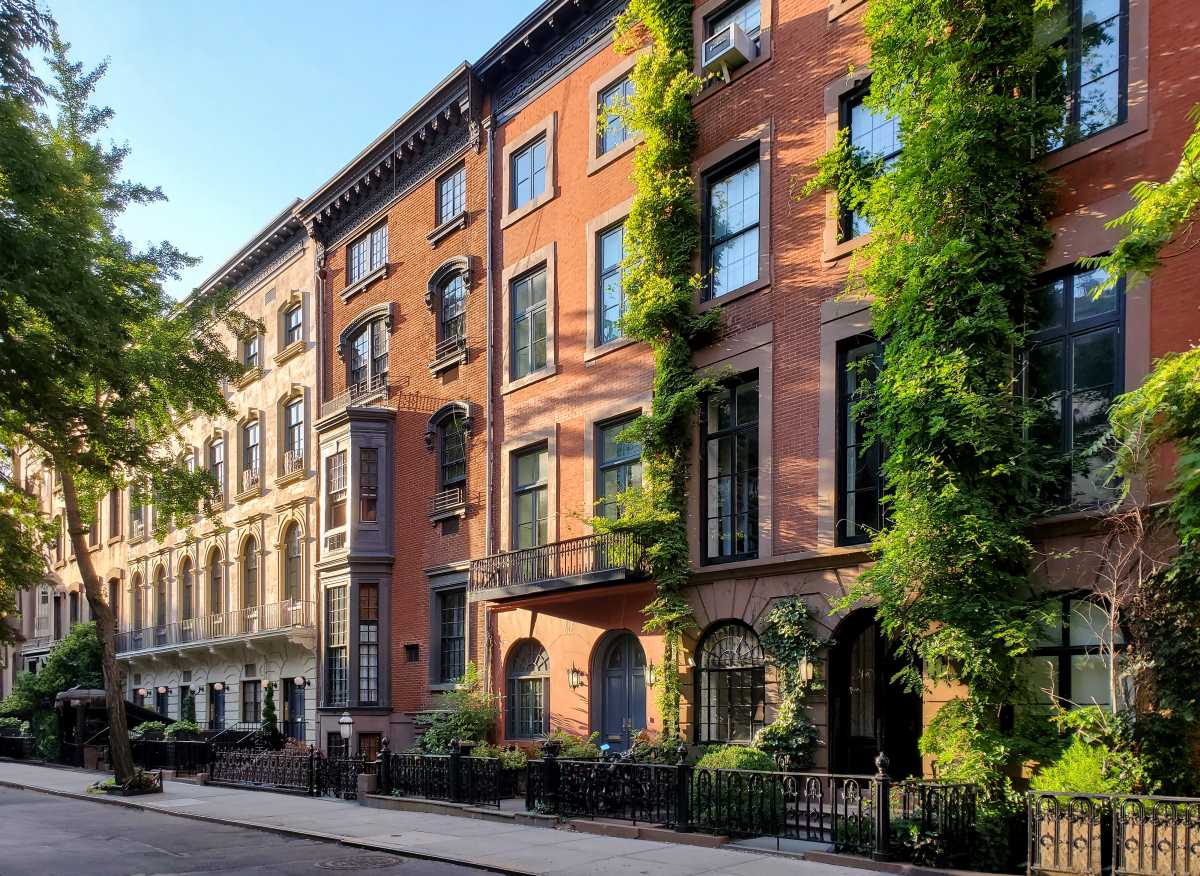-
 According to the LPC, Greenwich Village is the most quintessential New York City neighborhood of them all. “This supremacy comes from the quality of its architecture, the nature of the artistic life within its boundaries, and the feeling of history that permeates its streets,” the LPC said in its designation report.
According to the LPC, Greenwich Village is the most quintessential New York City neighborhood of them all. “This supremacy comes from the quality of its architecture, the nature of the artistic life within its boundaries, and the feeling of history that permeates its streets,” the LPC said in its designation report.
Both residents and tourists alike fall in love with the quaintness of the neighborhood, from its tree-lined streets to the unique architecture of the homes. “Walking through The Village at any time of day or night and in almost any direction, one is struck by the fact that one is in a part of the City which is very different from any other, remarkable for its old-world charm and outstanding as a great historic area of New York,” the LPC said in the report.
” data-id=”112305683″ data-link=”https://amnewyork.wpengine.com/wp-content/uploads/2019/10/15091_image.jpg” class=”wp-image-1.12305683″/>
Photo Credit: Craig Ruttle -
 Just west of Harlem, you’ll find a neighborhood known not just for its historically unique architecture but also for its cultural impact on the city. Although the neighborhood was predominantly white and upper middle class from the 1800s until about World War I, the Landmarks Preservation Commission says part of the designation of Hamilton Heights/Sugar Hill as a historic district was due to its central role in the Harlem Renaissance in the 1930s.
Just west of Harlem, you’ll find a neighborhood known not just for its historically unique architecture but also for its cultural impact on the city. Although the neighborhood was predominantly white and upper middle class from the 1800s until about World War I, the Landmarks Preservation Commission says part of the designation of Hamilton Heights/Sugar Hill as a historic district was due to its central role in the Harlem Renaissance in the 1930s.
During the 1920s, the area was known as Sugar Hill because “it was perceived as a place where life was ‘sweet,'” according to the LPC designation report.
” data-id=”112305717″ data-link=”https://amnewyork.wpengine.com/wp-content/uploads/2019/10/8610_image.jpg” class=”wp-image-1.12305717″/>
Photo Credit: Linda Rosier -
 In the early 19th century, Brooklyn was known as “a city of homes and churches,” and according to the Landmarks Preservation Commission, no neighborhood better exemplifies this than Park Slope. “…the Park Slope Historic District is one of the most beautifully situated residential neighborhoods in the city…” the LPC said in its designation report.
In the early 19th century, Brooklyn was known as “a city of homes and churches,” and according to the Landmarks Preservation Commission, no neighborhood better exemplifies this than Park Slope. “…the Park Slope Historic District is one of the most beautifully situated residential neighborhoods in the city…” the LPC said in its designation report.
Known for its wide, tree-lined streets, Park Slope offers a cross section of several important architecture trends, according to the LPC, including French Second Empire, neo-Greek, late Italianate, Queen Anne, Victorian Gothic and significant examples of Romanesque Revival houses.
” data-id=”112305731″ data-link=”https://amnewyork.wpengine.com/wp-content/uploads/2016/09/image-21.jpeg” class=”wp-image-1.12305731″/>
Photo Credit: Yeong-Ung Yang -
 Pretty much anyone who has rented in New York City is familiar with the terms “garden apartment” and “garden home,” but did you know Jackson Heights was one of the earliest neighborhoods to introduce such homes?
Pretty much anyone who has rented in New York City is familiar with the terms “garden apartment” and “garden home,” but did you know Jackson Heights was one of the earliest neighborhoods to introduce such homes? Even more unique is that nearly the entire neighborhood was conceived, planned, built and managed by a single real estate firm, the Queensboro Corporation, in the early 1900s.
The Landmarks Preservation Commission said in its designation report that Jackson Heights “comprises the most cohesive part of an innovative development which was mostly built between the early 1910s and the early 1950s, and which reflects important changes in urban design and planning that took place in the first three decades of the twentieth century.”
” data-id=”112305848″ data-link=”https://amnewyork.wpengine.com/wp-content/uploads/2019/10/8611_image.jpg” class=”wp-image-1.12305848″/>
Photo Credit: Linda Rosier -
 Described as Staten Island’s “most fashionable” 19th century neighborhood, St. George was actually one of the city’s earliest planned suburban developments, the Landmarks Preservation Commission says.
Described as Staten Island’s “most fashionable” 19th century neighborhood, St. George was actually one of the city’s earliest planned suburban developments, the Landmarks Preservation Commission says.
Similar to Fieldston, the Queen Anne- and Shingle-style homes in St. George accentuate the hilly topography. “It is these houses which give the proposed district its predominant architectural character,” the LPC said in its designation report.
As an added bonus, the neighborhood is also close to the Staten Island Ferry, providing an easy (and free) commute to Manhattan.
” data-id=”112305908″ data-link=”https://amnewyork.wpengine.com/wp-content/uploads/2019/10/8612_image.jpg” class=”wp-image-1.12305908″/>
Photo Credit: Anthony Lanzilote
In a city that is constantly changing, historic districts keep the memory of New York City’s past alive.
Tasked with achieving such a goal is the city’s Landmarks Preservation Commission, which handles the lengthy and thorough process of designating historic districts and landmarks throughout the five boroughs.
While we’re all pretty familiar with historic landmarks – the Woolworth Building, Central Park and the Empire State Building lobby to name a few – you may not know that the city also designates specific streets and sometimes entire neighborhoods as historic districts.
So what does it take to become a historic district?
According to the LPC, they are “areas of the city that possess architectural and historical significance and a distinct ‘sense of place.’”
In total, New York City boasts 139 historic districts and district extensions (when a historic district is expanded).
We couldn’t possibly highlight all of them, so here is a look at some of the most iconic and interesting historic districts representing all five boroughs.





































